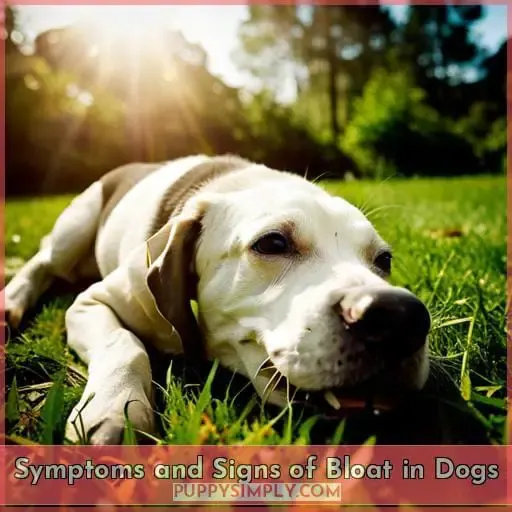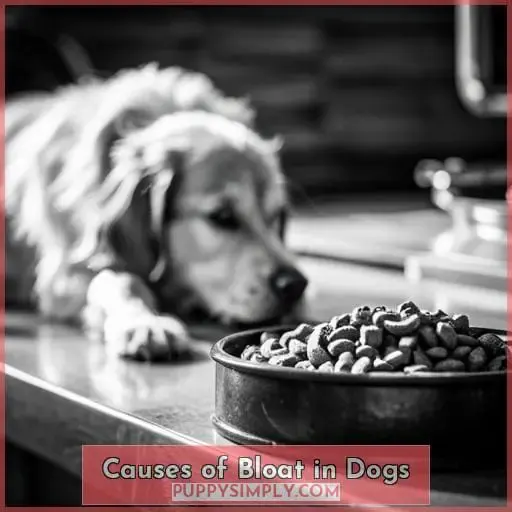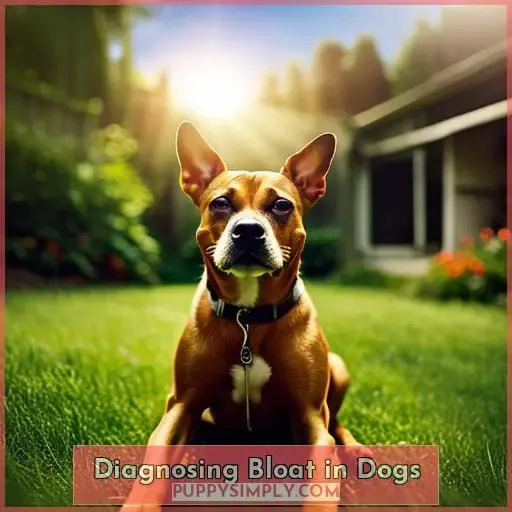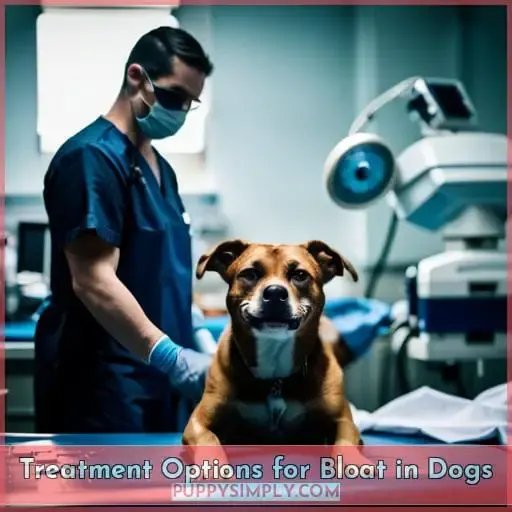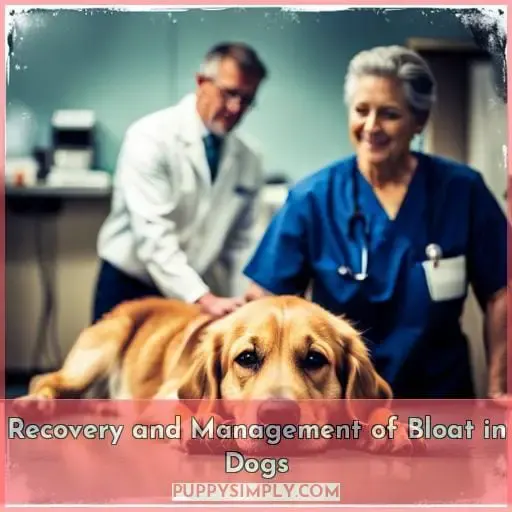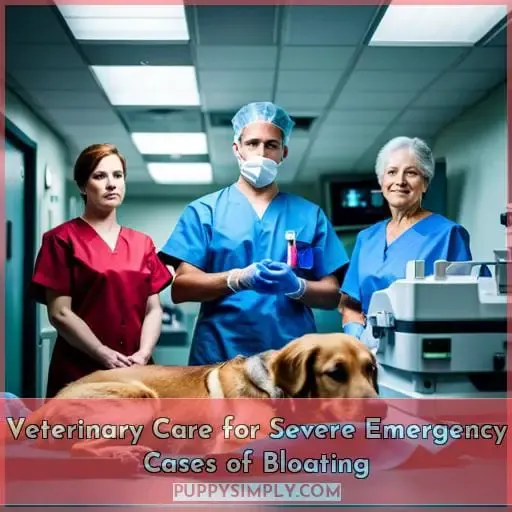This site is supported by our readers. We may earn a commission, at no cost to you, if you purchase through links.
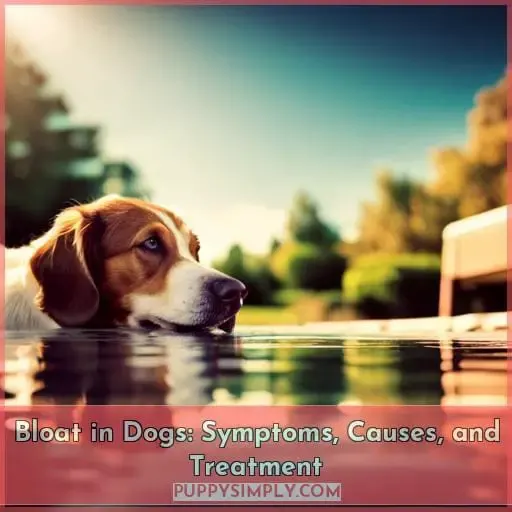 Are you worried about your pet’s bloated belly? Bloat in dogs, also known as gastric dilatation-volvulus (GDV), is a serious and potentially fatal condition. This article will discuss the symptoms, causes, treatment options, and how to prevent bloat from occurring again in your dog.
Are you worried about your pet’s bloated belly? Bloat in dogs, also known as gastric dilatation-volvulus (GDV), is a serious and potentially fatal condition. This article will discuss the symptoms, causes, treatment options, and how to prevent bloat from occurring again in your dog.
Knowing the signs of bloat can help you recognize it early on so that it can be treated quickly – before becoming life-threatening! Using active vigilance when dealing with water or food for your dog may save their life one day.
So let us dive into what every responsible pet owner should know about bloating in their canine companion!
Table Of Contents
- Key Takeaways
- What is Bloat in Dogs?
- Symptoms and Signs of Bloat in Dogs
- Causes of Bloat in Dogs
- Diagnosing Bloat in Dogs
- Treatment Options for Bloat in Dogs
- Recovery and Management of Bloat in Dogs
- Preventing Bloat in Dogs
- Different Degrees of Bloating in Dogs
- How to Help Your Dog Feel Better
- Veterinary Care for Severe Emergency Cases of Bloating
- Conclusion
Key Takeaways
- Bloat in dogs is a potentially fatal condition known as gastric dilatation-volvulus (GDV).
- Symptoms of bloat include dry heaving, abdominal distention, panting, and pacing.
- Risk factors for bloat include rapid ingestion of food or water before exercising and certain diets high in fat or oil content.
- Preventive measures include controlling food access, avoiding raised food bowls, and proper meal timing.
What is Bloat in Dogs?
You may not know it, but bloat can be a life-threatening condition for your canine companion, so understanding the severity and consequences of this medical emergency is essential to keeping them safe.
Bloat in dogs occurs when their stomach stretches due to food or gas, which causes abdominal pain. Severe cases can lead to gastric dilatation and volvulus (GDV), an emergency that restricts blood flow around major organs resulting in shock.
If left untreated, GDV could result in death within hours. GDV is the second leading cause of death among dogs after cancer.
Diagnosing bloat involves clinical signs, blood tests, and X-rays. Treatments range from fluids and medication for simple bloat cases to surgery for more serious ones like GDV.
Symptoms of bloat include dry heaving, panting anxiously, and pacing. Risk factors include rapid ingestion of food or water before exercising, as well as certain diets high in fat or oil content. Elevated bowls also pose an additional danger. All of these factors contribute towards an increased chance of developing this deadly condition, making preventive measures such as controlled access and intake vital steps one must take before it’s too late.
Including fresh human-grade foods reduces the risk by 59%, providing critical support against potential development and helping ensure long healthy lives with our beloved companions.
Symptoms and Signs of Bloat in Dogs
Be aware of the early signs of bloat, such as dry-heaving, abdominal distention, and pacing, so you can take quick action if needed. Recognize the symptoms to prevent or treat bloat before it becomes a life-threatening emergency.
Knowing when an emergency response is necessary and what preventive measures to take is crucial. Bloat is different from gastric dilatation and volvulus (GDV), which requires immediate veterinary care as it can cause shock in minutes due to its twisting stomach obstruction that cuts off blood supply to major organs.
Different breeds are more prone to bloat than others. Large dogs with deep chests have a higher risk, while smaller breeds have fewer occurrences and do not suffer severe consequences like GDV does.
To prevent bloat, control food access, avoid raised bowls after meals or exercise, and feed multiple small meals daily instead of one large meal containing fat or oils. Slow down eating habits by using interactive feeders or puzzle toys. Limit water intake immediately after eating dry food, especially before exercise or activity.
Monitoring your pet’s behavior closely will help catch any potential issues quickly, allowing time for treatment and reducing the chances of further complications or death resulting from this condition.
Causes of Bloat in Dogs
Understanding the causes of bloat in dogs is essential to ensure their health and well-being. Overeating, swallowing air, gastric dilatation-volvulus (GDV), intestinal obstruction, and parasites can all be contributing factors for this life-threatening condition.
Overeating
Overeating is one of the top causes of bloat in dogs. Prevent it by managing portion sizes, recognizing hunger cues, and establishing healthy eating habits. Feeding multiple small meals daily can help reduce the risk, and adding fresh food strengthens stomach walls to lower gas build-up.
Swallowing Air
Swallowing air can also lead to bloat, which is like a balloon slowly filling up with hot air until it pops. Air ingestion may cause discomfort and gas-related pain in dogs, leading to bloating.
- Limiting water intake after meals;
- Slowing down eating speed;
- Avoiding raised food bowls. Canines can suffer from aerophagia if unattended, so prompt veterinary attention is essential when risk factors are present or symptoms arise. Bloating prevention should be part of any dog care routine for optimal health!
Gastric Dilatation-Volvulus (GDV)
Gastric Dilatation-Volvulus (GDV) is a life-threatening emergency where the stomach twists and flips, cutting off blood supply to major organs. GDV can lead to shock, organ damage, or even death in just hours without proper treatment.
Surgery may be needed for severe cases with gastropexy as a preventive measure against future occurrences of bloat.
Awareness of risk factors such as elevated food bowls or post-meal exercise is important for GDV prevention. Veterinary intervention is crucial when symptoms present themselves. Proactive steps like having small meals and controlling water intake help reduce the chance of this condition developing in dogs – ultimately providing peace of mind about their health and well-being.
Intestinal Obstruction
Intestinal obstruction can be life-threatening for your pup, so knowing the signs is key. Prevention and recognition are essential: dietary considerations, emergency response, and intestinal health. Prone breeds need extra care to prevent bloating. Helping your dog with a bloated belly requires swift treatment of bloat causes.
Parasites
Parasites can be a cause of bloat in dogs, so it is important to stay vigilant. Prevention includes keeping your pet hydrated and fed appropriately. Outdoor risks include contact with other animals or contaminated soil/water. If symptomatic, treatment may involve surgery and medication; risk factors are older age, deep-chested breeds, etc.
Diagnosing Bloat in Dogs
When a dog is suspected of having bloat, it is important to perform a physical examination and diagnostic tests for confirmation. This includes abdominal palpation to check for distention, pain, fluid buildup, or any other abnormalities.
Diagnostic tests such as X-rays can also be used to understand the severity of the issue and help determine an appropriate treatment plan.
Physical Examination
You can assess your pup’s potential for bloat with a physical examination. Check the abdomen for distention, listen to the stomach contents, and look for signs of pain. Also, evaluate any other clinical signs that may point to bloat, such as pacing or restlessness.
A veterinary evaluation should include abdominal palpation and an assessment of vital parameters, such as heart rate and respiratory rate.
- Abdominal distension
- Listen to stomach contents
- Look for pain signals
- Evaluate clinical symptoms
- Veterinary evaluation includes palpation and vital parameter checkup
Diagnostic Tests
To diagnose bloat, your vet will likely run a few diagnostic tests, including blood work and abdominal X-rays, to assess the severity of the condition. They may also use imaging techniques such as ultrasound to detect fluid buildup in the abdomen.
Lab analysis helps determine if there is an infection present or any other underlying causes for bloat.
A complete medical evaluation is necessary for proper diagnosis and treatment plan development. Diagnostic tests are essential in establishing a comprehensive understanding of your pet’s health status and potential complications that may arise from GDV or other conditions related to bloat.
With this knowledge, vets can create an effective treatment plan to ensure their patient’s safety and wellbeing while minimizing risks associated with this life-threatening emergency.
Treatment Options for Bloat in Dogs
When dealing with bloat in dogs, understanding the available treatment options is crucial for successful resolution. Depending on the severity of symptoms and diagnosis, treatment may involve stabilization measures such as fluids and pain medications, decompression of stomach gas or fluid to reduce abdominal pressure, or surgery to correct any gastric torsion present.
Stabilization
Once you’ve been able to diagnose bloat in your dog, stabilizing them is key for their recovery. Stabilization includes fluid administration and stomach decompression, followed by surgery if necessary.
Post-bloat care involves preventive measures such as controlling food access and avoiding raised food bowls. Recovery time varies but usually takes 1-2 days for simple bloat cases and longer periods of time for GDV cases.
Monitoring at home can be dangerous considering the condition’s rapid progression; it requires immediate veterinary attention to ensure a successful outcome.
Decompression
If your dog is suffering from bloat, decompression may be necessary to relieve the abdominal pressure and reduce the risk of further complications. Decompression techniques include fluid therapy, gastric torsion reversal procedures, emergency surgery for severe cases, and more.
These methods can help release gas buildup in the stomach and prevent any further damage to organs or tissues. Veterinary professionals are equipped with a variety of tools that allow them to properly assess a pet’s condition before proceeding with treatment options such as decompression.
Surgery
In cases of GDV, surgery is often necessary to return the stomach to its rightful place and repair any tissue damage. The surgical intervention stabilizes the stomach’s position, restores blood flow, eliminates potential for further injury, and severs ligaments that have formed from twisting.
Postoperative care requires monitoring for shock or infection and may involve medications and dietary changes. Surgical risks include complications during anesthesia, bleeding, wound infections, or hernias post-surgery but can be minimized with proper preoperative care.
Long-term effects depend on severity but may cause organ failure if not managed properly throughout the recovery process. Proper treatment is essential in returning dogs back to their healthy state after bloat occurs.
Recovery and Management of Bloat in Dogs
You can help your pup recover from bloat and manage the condition with some preventative measures. A holistic approach to recovery strategies, dietary management, exercise guidelines, and long-term care is essential for successfully preventing future episodes.
To start off on the right foot, you need to slow down your dog’s eating pace by using a puzzle feeder or spoon-feeding them. Feeding multiple smaller meals daily can also be beneficial in preventing bloat.
Try adding fresh vegetables such as carrots or green beans into their diet while avoiding high-fat foods such as bacon or beef jerky.
In terms of water intake, limit it immediately after meals, especially when they are consuming dry food.
Another important factor is allowing at least an hour before any vigorous activity post-meals.
Taking these steps should pave the way for successful prevention against further complications from developing, considering how dangerous GDV can be if left untreated even within minutes after onset!
Preventing Bloat in Dogs
It’s important to take preventive measures when it comes to preventing bloat in dogs. Controlling food access, avoiding raised food bowls, timing meals and exercise properly, understanding dietary factors, and implementing slow eating techniques as well as controlled water intake are all helpful strategies for reducing the risk of bloat.
Controlled Food Access
By controlling food access, you can reduce the risk of bloat by up to 59%. Properly portion meals and time them before or after exercise to help. Drinking in moderation is key. Regulate water intake too; avoid excessive amounts prior to activity.
Let your dog rest after eating before beginning any intense movements and place their bowl on the ground instead of elevated surfaces.
Avoiding Raised Food Bowls
Avoid elevating your pup’s dinner bowl. Reduces bloat risk: Use feeding stands less; lower food height; avoid elevated dishes. Keeps the stomach in a natural, relaxed position–prevents gas build-up and torsion.
Meal Timing and Exercise
It is important to limit vigorous activity after meals and ensure appropriate meal timing in order to reduce the risk of bloat in dogs. Feed multiple smaller meals throughout the day and restrict water consumption immediately following food intake.
Slow down your dog’s eating speed and allow for at least an hour of rest before exercise or playtime. This will help minimize gas buildup while also maintaining a healthy diet that reduces the risk of bloat by 59%.
Dietary Factors
Be mindful of dietary factors that can increase bloat risk. High-fat or oily foods, large meals in one sitting, and poor food choices all contribute. Plan nutritious meals with variety to reduce risks; smaller portions spread throughout the day are best for digestion.
Slow Eating
Slow down your pup’s eating to help prevent bloat. Fresh human-grade food reduces the risk by 59%. Create healthy mealtime habits: choose an appropriate bowl, monitor behavior, and use slow feeding methods.
Encouraging proper chewing improves digestion and lessens the chances of bloating.
Controlled Water Intake
Controlling your pup’s water intake is key to preventing bloat. Manage hydration with these tips: 1) Divide the daily allowance into multiple servings, 2) Don’t give too much at once, 3) Provide fresh and clean water frequently throughout the day, 4) Limit access before or after meals.
Properly managing fluids helps keep dogs healthy and avoids excessive drinking, which can lead to bloat.
Different Degrees of Bloating in Dogs
Bloating in dogs can vary from mild to severe and even chronic. Mild bloating can be caused by eating too much, drinking water too quickly, or overexertion after a meal, while moderate bloating is usually associated with gastritis, intestinal blockages, or other digestive issues.
Severe bloat often leads to Gastric Dilatation-Volvulus (GDV), which requires immediate veterinary attention, whereas chronic bloat may indicate an underlying health condition such as metabolic disease or cancer.
Mild Bloating
Mild bloating in dogs is often characterized by abdominal distention, anxiety, pacing, and panting. It can be managed through prevention tips such as controlling water intake and dietary considerations like small meals or whole foods.
To reduce the risk of bloat, limit exercise after meals and avoid raised food bowls. Symptoms to watch for include dry heaving, elevated heart rate, pale gums, or collapse.
Moderate Bloating
When it comes to moderate bloating in dogs, how can you tell if your pup is suffering? Symptoms may include abdominal distention, dry heaving, and pacing. Hydration management, dietary considerations, and exercise precautions are important for prevention.
Holistic approaches such as fresh food consumption and controlled water intake help reduce the risk. Preventive measures like avoiding raised bowls or post-meal exercises are essential for keeping bloat at bay.
Severe Bloating
Left untreated, severe bloat can quickly become life-threatening and put your beloved pup in grave danger. Emergency intervention is critical to save a dog’s life who has GDV or gastric dilatation volvulus.
Symptoms such as pale gums, collapse, elevated heart rate, pacing, and panting require immediate veterinary care with intensive critical care unit treatment for the best outcomes.
Risk factors for GDV include large size/breed, quick food/water intake, and post-meal exercise, which may contribute to the condition. Prevention involves controlling access to food and water while closely monitoring after meals.
Additionally, incorporating whole foods into your dog’s diet can help strengthen the stomach wall, reducing the risk of bloat by 59%.
Chronic Bloating
Chronic bloat can occur when a dog experiences repeated episodes of bloating over an extended period of time, potentially leading to long-term health complications. For example, one beloved pup had difficulty breathing after months of chronic bloating and was in need of urgent medical attention.
Managing this condition requires dietary considerations, lifestyle adjustments, and preventive measures such as controlled food access and water intake. Long-term care involves feeding multiple small meals daily with whole foods that strengthen the stomach wall to reduce the risk of gas build-up.
To prevent bloat altogether, avoid post-meal exercise or activities for at least an hour after eating while closely monitoring your dog’s eating speed.
How to Help Your Dog Feel Better
Helping your dog feel better when they’re bloated doesn’t have to be a hassle. By providing smaller meals, ensuring a well-balanced diet, staying hydrated, and avoiding certain foods while slowing down their eating habits, you can make sure your pup is feeling great in no time!
Smaller Meals
Feeding your pup smaller meals throughout the day can help reduce their risk of bloat. Consistent meal frequency and portion control offer nutritional benefits for weight management and digestive health.
A balanced diet is key, so look for quality ingredients in each serving tailored to your dog’s needs.
Multiple small meals also aid digestion while decreasing food intake at once, which helps prevent bloating or discomfort after eating too much too quickly. Utilizing appropriate meal sizes can be beneficial both nutritionally and emotionally as it creates a predictable routine that encourages appetite stimulation at mealtimes, as opposed to grazing throughout the day.
Well-Balanced Diet
Providing your pup with a well-balanced diet can help reduce the risk of bloat. Meal planning, dietary guidelines, and nutritional needs should be taken into account when selecting food choices. Balance nutrition to ensure all health benefits are reaped; proper meals provide energy for growth and activity while supporting overall wellness.
Hydration
Keeping your pup well-hydrated is key to helping them feel their best! Dealing with thirst, setting hydration strategies, and balancing fluids are important for bloat prevention.
Avoiding Certain Foods
To help your pup feel better, avoid foods high in fat or oils. Mealtime strategies: Feed smaller meals; whole foods strengthen the stomach wall; slow down eating. Hydration tips: Limit water intake after meals, especially dry food; wait 1 hour for exercise post-meal.
Bloat triggers: Quickly consuming food/water, raised bowls, and dietary factors increase the risk. Dietary precautions include controlling access and avoiding certain fats/oils to lower bloat chances.
Slowing Down Eating
Help your pup feel better by slowing down mealtime – take the time to savor each bite! Prevent overeating with slower-paced meals, food bowl height adjustments, hydration management, and dietary recommendations.
Optimize digestion and reduce the risk of bloat by controlling portion sizes or splitting up feedings throughout the day. Provide frequent breaks from eating for relaxation and avoid excessive drinking before exercise.
Veterinary Care for Severe Emergency Cases of Bloating
If your dog is exhibiting signs of severe bloat, it’s important to act immediately and seek veterinary help. In the case of a life-threatening GDV emergency, rapid response from a veterinarian is essential for saving your dog’s life.
Emergency intervention may include:
- Surgical procedures such as stomach tacking or gastropexy to prevent future twisting and flipping of the stomach wall
- Intravenous fluids treatment with pain medications
- Electrocardiogram (ECG) monitoring to check heart rate during surgery
- Critical care following surgery in order to monitor recovery progress
Timely action by both pet owners and veterinarians can potentially save lives through emergency interventions when dogs suffer from bloat or GDV complications. It’s important that pet parents are aware of symptoms associated with bloating so they can respond quickly if their canine companion needs urgent medical attention.
Conclusion
It’s a scary thought that a health condition that can cause a severe medical emergency can affect any dog breed. The truth is, bloat in dogs is a very real and potentially fatal emergency if not treated quickly.
Symptoms of bloat can range from dry-heaving and abdominal distention to panting, pacing, and anxiety.
Knowing the risk factors such as overeating, swallowing air, and specific dietary factors can help prevent the condition. There are various treatments available for bloat depending on the severity, from hospitalization and intravenous fluids to surgery.
To help manage and reduce the risk of bloat in your dog, try to control food access, avoid raised food bowls, feed multiple smaller meals daily, and limit water intake immediately after meals. Taking care of your furry friend is important, and awareness and preparation can help save their life.


